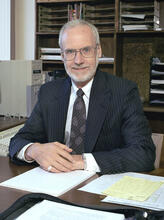 Distinguished Professor Emeritus Alan George used to joke that he couldn’t keep a job. In truth, he so excelled in his many roles with the University that he was continually offered new ones. In his long and illustrious career, he was Dean of the Faculty of Mathematics twice (1980-1986, 1998-2005); Vice-President, Academic and Provost (1988-1993); Associate Provost, Information Systems and Technology (2003-2012); interim Vice-President, University Research (2006-2007); and interim Dean of Graduate Studies (2007-2009).
Distinguished Professor Emeritus Alan George used to joke that he couldn’t keep a job. In truth, he so excelled in his many roles with the University that he was continually offered new ones. In his long and illustrious career, he was Dean of the Faculty of Mathematics twice (1980-1986, 1998-2005); Vice-President, Academic and Provost (1988-1993); Associate Provost, Information Systems and Technology (2003-2012); interim Vice-President, University Research (2006-2007); and interim Dean of Graduate Studies (2007-2009).
Dr. George balanced these leadership duties with a remarkable research career for which he was recognized with the Governor-General’s Commemorative Medal for the 125th Anniversary of Canada, the Canadian Applied and Industrial Mathematics Society Research Prize and a lifetime achievement award from the Canadian Association of Computer Science. He is a Fellow of the Royal Society of Canada, the Society of Industrial and Applied Mathematics and the Institute of Electrical and Electronics Engineers.
University historian Kenneth McLaughlin (BA ’65), recognizing Dr. George’s service to the University, dubbed him a “man for all seasons” in the University of Waterloo’s 50th-anniversary book Out of the Shadow of Orthodoxy.
And his impact on the University continues in retirement. Recently, Dr. George donated $200k to the CEMC’s Elementary School Innovation Fund. This built on an already impressive legacy of giving that included the creation of the J. Alan George Leadership Award and the IST Staff Appreciation Fund.
Thanks to Dr. George and other donors, the CEMC’s new Elementary School Innovation Fund will help develop free online courseware and accompanying materials that cover the mathematical content taught in Grades 4/5/6 in ways that are accessible and appropriate for these younger audiences and their teachers. CEMC already offers similar courseware for students in Grades 7 to 12, and it has proven wildly successful, particularly during the pandemic when demand for the materials skyrocketed.
Numeracy for all: the evolution of the Faculty’s founding vision
Dr. George describes himself as having been a “fan of the CEMC forever.” In his view, the CEMC is the continuation of an ambition that originated with the one of the founders of Faculty of Mathematics, Ralph Stanton.
"One of the forward looking things that Stanton did was to hire a couple of very well-connected high school teachers–Ron Dunkley and Ken Fryer–who, in addition to their professorial duties, traveled around to Ontario high schools and gave presentations,” says Dr. George.
These were not garden-variety recruitment talks, which were rare and even frowned upon in those days, but rather in-depth lectures about things like number theory. Dr. George had the opportunity to attend several and saw firsthand how the speakers captivated their audience.
“You could just see the students just go, ‘Wow, this is so interesting,’” says Dr. George.
While these presentations likely spurred applications to the University of Waterloo, this was not their primary purpose. Rather, they were intended to promote numeracy and interest in mathematics in the broader community. From early on, the Faculty of Mathematics saw its role not just as educating those students who walked through its halls, but all learners, no matter where they lived or what they aspired to become in life.
The CEMC evolved out of this vision. Indeed, Ron Dunkley went on to become its founding director.
“There are several reasons why I am such a big fan of the CEMC,” says Dr.George. “First, over the years, it has enlarged its contest offerings to appeal to students of increasingly junior levels. Second, it has focused on encouraging interest in mathematics and computer science among young girls. Finally, it has expanded its footprint geographically: it focuses not only on students and teachers in Canada or North America, but students and teachers worldwide.”
To Dr. George’s point, more than 265,000 students in over 80 countries register for the CEMC’s 15 contests each year, and 20,000 students benefit each year from the CEMC Visits Schools program at more than 300 schools in over 15 countries.
Dr. George also commends the CEMC for its understanding of the importance of teachers. “I think the CEMC does a marvelous job of not just encouraging interest in math and computing among students, but they recognize that teachers are crucial to that endeavor,” says Dr. George.
Having seen the impact of Dunkley and Fryer’s talks, and himself become an influential teacher, Dr. George knows the difference that educators can make. And exceptional teachers have never been more necessary to our school system. Dr. George notes the “profound” negative impacts of the pandemic on childhood education.
But he believes the CEMC can offset these effects, especially given its penchant for “growing and evolving and always seeing the bigger picture.”






